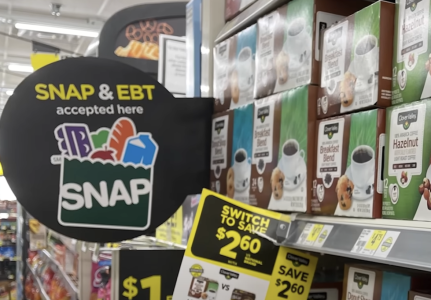Could your taxes go up? What to know about the new proposal tied to SNAP benefits
By
Veronica E.
- Replies 0
If you’ve been keeping an eye on headlines, you may have seen growing debate around taxes, school meals, and food assistance programs.
At the center of it all is SNAP—the Supplemental Nutrition Assistance Program—which helps millions of Americans, including older adults, afford groceries when budgets are tight.
A sweeping new federal law has shifted more responsibility for SNAP onto the states, leaving them with a major funding gap.
In response, Colorado lawmakers have proposed a tax change targeting the state’s wealthiest households.
Whether or not it passes will be up to voters this November—and the outcome could impact families, seniors, and students alike.

SNAP has long been a federally funded safety net for over 42 million Americans.
But under a new federal law known as the One Big Beautiful Bill Act, states will soon be required to pick up a much larger share of the program’s administrative costs.
In Colorado, that means at least $50 million more each year—starting in fiscal year 2026–2027—just to keep SNAP running smoothly.
The law also includes a penalty clause: if a state’s SNAP payment error rate rises above 6%, it must begin covering part of the benefit payments too.
In addition, the law also eliminates SNAP-Ed, a popular nutrition education program that helped families learn how to stretch their grocery budgets and eat healthier.
That alone will cost Colorado an additional $6 million in lost support each year.
In response to these looming costs, Colorado lawmakers have proposed Proposition MM, which would raise about $95 million a year by limiting state income tax deductions for residents earning more than $300,000.
Single filers would see their deductions capped at $1,000, and joint filers at $2,000.
The average impact? Around $486 more per year for those high-income households.
How would the money be used?
Lawmakers have laid out a three-part plan:
Supporters of the measure argue that the federal government’s cuts are harsh—and that the state has a responsibility to step in.
“What we are asking the voters is to please allow any money overage that we might collect for Healthy School Meals for All, after HSMFA is fully funded, to go to SNAP to cover the shortfall,” said Senator Dafna Michaelson Jenet.
Opponents see things differently.
Senator Lisa Frizell questioned whether the state should focus on efficiency before reaching into taxpayer pockets: “Are we doing the best job at administering this?”
Others warn that without the funding, counties may struggle to deliver services.
Heather O’Hare, Director of Human Services for Larimer County, emphasized that a reduction in SNAP support would “absolutely have a direct impact on the service delivery and the ability of counties to maintain service levels to these vulnerable Coloradans.”
Thanks to Colorado’s Taxpayer Bill of Rights (TABOR), any proposed tax increase must go to the public for approval.
Proposition MM is expected to appear on the November 2025 ballot, giving voters the power to decide whether to raise taxes on high-income residents to support free school meals and food assistance.
If the measure passes, Colorado may become a model for other states navigating similar SNAP budget pressures.
If it fails, lawmakers will need to explore other solutions—while families, seniors, and schools brace for potential service cuts.
Even outside of Colorado, the outcome of this proposal may have wider significance.
As federal policies shift more program costs to the states, others may soon face similar decisions about how to fund food assistance.
Some may consider raising taxes, others might look to reduce benefits, or explore new approaches to service delivery.
The choices made in Colorado this fall could help shape future responses to food security challenges across the country.
For older adults, this issue remains especially relevant.
Nearly 5 million seniors nationwide use SNAP benefits, and many understand the role these programs play in supporting families and communities.
As funding structures evolve, the broader conversation about how best to maintain access to food assistance is likely to continue.
At the center of this discussion are broader questions about public responsibility and resource allocation.
Should higher-income households contribute more to help fund statewide programs like school meals and food assistance?
What role should states play in supporting programs that have traditionally been federally funded?
And how can policymakers balance fiscal efficiency with the need to maintain essential services for those who rely on them?
Read next: Your favorite restaurants could soon accept SNAP benefits—here’s what you need to know!

Would you support a measure like this if it came to your state? Should high-income earners pay more to fund school meals and SNAP, or is there a better way to balance the budget? Have you or someone you know ever relied on these programs?
We’d love to hear your story—your voice could help shape how communities across the country respond to these changes.
At the center of it all is SNAP—the Supplemental Nutrition Assistance Program—which helps millions of Americans, including older adults, afford groceries when budgets are tight.
A sweeping new federal law has shifted more responsibility for SNAP onto the states, leaving them with a major funding gap.
In response, Colorado lawmakers have proposed a tax change targeting the state’s wealthiest households.
Whether or not it passes will be up to voters this November—and the outcome could impact families, seniors, and students alike.

Colorado’s proposed tax change would raise $95 million to fund school meals and SNAP, with voters deciding the outcome in November. Image Source: YouTube /
PBS NewsHour.
PBS NewsHour.
The SNAP shake-up: What changed and why it matters
SNAP has long been a federally funded safety net for over 42 million Americans.
But under a new federal law known as the One Big Beautiful Bill Act, states will soon be required to pick up a much larger share of the program’s administrative costs.
In Colorado, that means at least $50 million more each year—starting in fiscal year 2026–2027—just to keep SNAP running smoothly.
The law also includes a penalty clause: if a state’s SNAP payment error rate rises above 6%, it must begin covering part of the benefit payments too.
In addition, the law also eliminates SNAP-Ed, a popular nutrition education program that helped families learn how to stretch their grocery budgets and eat healthier.
That alone will cost Colorado an additional $6 million in lost support each year.
Also read: SNAP reductions may impact seniors the most in these 15 states
The state’s proposed solution: Targeted tax reform
In response to these looming costs, Colorado lawmakers have proposed Proposition MM, which would raise about $95 million a year by limiting state income tax deductions for residents earning more than $300,000.
Single filers would see their deductions capped at $1,000, and joint filers at $2,000.
The average impact? Around $486 more per year for those high-income households.
How would the money be used?
Lawmakers have laid out a three-part plan:
- Fully fund free school meals through the state’s Healthy School Meals for All program.
- Improve meal quality by supporting higher pay for cafeteria workers and using more local ingredients.
- Use leftover funds to help cover Colorado’s increased SNAP costs and administrative efforts.
Also read: Big changes to SNAP could reshape grocery shopping across America
What supporters and critics are saying
Supporters of the measure argue that the federal government’s cuts are harsh—and that the state has a responsibility to step in.
“What we are asking the voters is to please allow any money overage that we might collect for Healthy School Meals for All, after HSMFA is fully funded, to go to SNAP to cover the shortfall,” said Senator Dafna Michaelson Jenet.
Opponents see things differently.
Senator Lisa Frizell questioned whether the state should focus on efficiency before reaching into taxpayer pockets: “Are we doing the best job at administering this?”
Others warn that without the funding, counties may struggle to deliver services.
Heather O’Hare, Director of Human Services for Larimer County, emphasized that a reduction in SNAP support would “absolutely have a direct impact on the service delivery and the ability of counties to maintain service levels to these vulnerable Coloradans.”
Also read: Lawsuit filed against Trump Administration over SNAP benefit changes
Voters have the final say
Thanks to Colorado’s Taxpayer Bill of Rights (TABOR), any proposed tax increase must go to the public for approval.
Proposition MM is expected to appear on the November 2025 ballot, giving voters the power to decide whether to raise taxes on high-income residents to support free school meals and food assistance.
If the measure passes, Colorado may become a model for other states navigating similar SNAP budget pressures.
If it fails, lawmakers will need to explore other solutions—while families, seniors, and schools brace for potential service cuts.
Also read: SNAP benefits hit by massive scam surge—are your funds at risk?
Why this matters—no matter where you live
Even outside of Colorado, the outcome of this proposal may have wider significance.
As federal policies shift more program costs to the states, others may soon face similar decisions about how to fund food assistance.
Some may consider raising taxes, others might look to reduce benefits, or explore new approaches to service delivery.
The choices made in Colorado this fall could help shape future responses to food security challenges across the country.
For older adults, this issue remains especially relevant.
Nearly 5 million seniors nationwide use SNAP benefits, and many understand the role these programs play in supporting families and communities.
As funding structures evolve, the broader conversation about how best to maintain access to food assistance is likely to continue.
Also read: Could a SNAP benefits error cost your state millions? Here’s what taxpayers need to know
Food security, community, and shared responsibility
At the center of this discussion are broader questions about public responsibility and resource allocation.
Should higher-income households contribute more to help fund statewide programs like school meals and food assistance?
What role should states play in supporting programs that have traditionally been federally funded?
And how can policymakers balance fiscal efficiency with the need to maintain essential services for those who rely on them?
Read next: Your favorite restaurants could soon accept SNAP benefits—here’s what you need to know!
Key Takeaways
- Colorado faces at least $50 million in new annual SNAP administrative costs starting in 2026–2027, plus $6 million in lost nutrition education funds.
- Proposition MM would limit tax deductions for households earning over $300,000, raising an estimated $95 million a year.
- Funds would first go toward school meals, then cafeteria wages and food improvements, and finally toward offsetting SNAP program costs.
- Voters will decide on the measure this November, setting a precedent for how states handle federal cost shifts in essential food programs.
Would you support a measure like this if it came to your state? Should high-income earners pay more to fund school meals and SNAP, or is there a better way to balance the budget? Have you or someone you know ever relied on these programs?
We’d love to hear your story—your voice could help shape how communities across the country respond to these changes.






